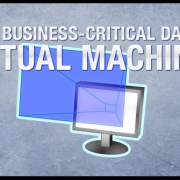KineticD Online Data Backup Expert Tips: Backing Up Your Company’s Database Online
Regardless of the fact that the benefits of using online data backup are becoming more and more commonly understood every day, many consumer-level computer users are still continuing to back up their systems to external devices, leaving them vulnerable to natural disasters, theft, human error and the potential failure of the devices that they are backing up to in the first place. The question is, with online data backup so affordable and convenient, why are these people continuing to backup the old fashioned way? Could it be that their data is not important enough to them to thoroughly think this issue through?
However, when it comes to safeguarding the data stored on company databases, the switch to online backup has been much more rapid indeed. This is primarily due to the fact that if you have a whole company relying on the safety of the information stored in a database, you are certainly going to be sure to stay as informed as possible about the most secure and efficient backup methods available. In addition to this, while the large amounts of data commonly contained in company databases have in the past taken relatively long amounts of time to back up online, increased Internet speeds and more efficient methods of incremental backup have made the process much faster, and thus even more popular.

So, how exactly does one go about backing up a database online? The first major step is configuring the database itself to be as ready as possible for backup using the tools already made available by the data base management system, which is the software that powers the database in the first place. This will save you valuable time during the online backup process. In this procedure, the data in the database is usually extracted into a more coherent form in order to be organized into folders that will be ready for transfer to the online backup provider’s servers. During this process, “live” or commonly used files, and files that haven’t been accessed for some time are often split up, due to the fact that the most efficient method in which these two types of data will be backed up should be different, with time being saved by utilizing a simpler method for the less commonly used files. Then, the Metadata for the files are also extracted and saved into separate folders in preparation for transfer to the online backup company’s servers.
Timing is also a crucial factor when attempting to perform a thorough, successful backup of any database. The person in charge of the database should analyze when it is usually at its lowest level of activity in order to minimize the number of files that will be live at that time. Sometimes, depending on the nature of the company using the database, some people find themselves in the position where there is no real ideal downtime in which to perform the data backup transfer. If this is the case, an entirely incremental method, in which the database is always being backed up as files change, is usually the best way to go.
Another issue that must be analyzed is the amount of disc space that will be required on the online backup company’s servers in order to fully backup the database. When doing this, it is important to keep in mind that the quantity of information that a database actually contains is usually much smaller than the size of the database itself, due to the fact that empty spaces usually exist throughout databases. Exactly how much empty space a database contains can generally be easily ascertained by entering a few simple commands into the database management system. After having performed this activity, it will then become time to schedule when the backups will occur, and finally, once you have performed the backup of the database, it is also imperative that you occasionally download files that you have backed up from your online service provider in order to make sure that they are indeed doing their job by properly storing and protecting your data.
We here at KineticD are proud to have one of the most advanced and efficient systems around when it comes to backing up databases. Our patented Continuous Backup system will effectively render many of the above steps fully automated, and we also use advanced data backup methods that will treat your database as one file, further simplifying the process of online database backup. To learn more about this and all our other online data backup services, please visit https://kineticd.com/ today.






Leave a Reply
Want to join the discussion?Feel free to contribute!